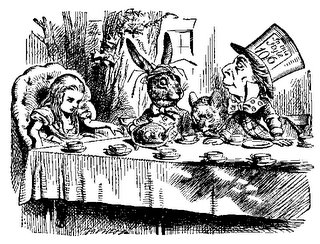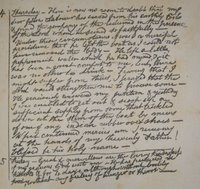
In April 2005, I tossed the microwave and I thought I'd report on that event, and its aftermath, as my first official "personal post" here at Everyday Simplicity.
Long story short: haven't missed it. Not even once.
Why did I do it?In Spring 2005, I read
The Maker's Diet and that led me to surfing the web, learning about the safety (or lack thereof) of microwaved food. Skeerey stuff, more details on that down below.
How'd I do it? Well, first, I prepared myself for what I perceived to be a
tremendous sacrifice. (I gave myself permission to sigh a lot, and I ate more chocolate.) Then, I kept a list of how I used the machine - kept it up for a couple of weeks.
What a revelation: I only used it to heat water for tea, and once to defrost some chicken. I was surprised. So, on the last day of the month, surprisingly without angst, I unplugged it and toted the thing out to the alley, for garbage pickup. Away it went.
Today, I can report that I'm glad it's gone. Not only for the health benefits (again, all those details are still to come), but it increased my quality of life. Seriously.
Now, I boil hot water in a wonderful blue tea kettle, and listen for the whistle. Then, I use one of a collection of tea pots to brew tea for the daily pitcher of iced tea or I have a pretty tea mug at the ready, for a single cup.
Sure, I'm not standing at the counter waiting for a ping, but I've got the time to take care of a little thing while I'm waiting for the whistle. I get the paper, I unload the top rack of the dishwasher, I water some plants. We're not talking a big time differential here - the mug has water for tea within three minutes with a kettle.
Defrosting means thinking ahead or revising the dinner menu if I forget. That's okay. I've found that over time, I'm not forgetting anymore - it's like I've settled into something here. I'm cooking at home for almost all my meals now, something I wasn't doing in April 2005. But I suppose that's the topic of another post.
Back to the 'wave. I do admit to getting a toaster oven, so I could heat or cook or toast without firing up the big Westinghouse oven. In 5-10 minutes, I have hot food that has real brown marks on it and no rubber corners.
I think that this one change has influenced other positive changes in my life, albeit in a small way. My mornings feel cozy when that kettle sounds, and the three minutes instead of 50 seconds for the mug in its own way forces me to keep a slower, steadier pace. There's a ritual here that I see in old movies, read about in books set in the English countryside. Suddenly, I'm a part of all that.
It's a simpler way of living, and I like it.
Now, about the health issues of microwaved food.
1. "People who ingested microwaved foods showed a statistically higher incidence of stomach and intestinal cancers, plus a general degeneration of peripheral cellular tissues and a gradual breakdown of the function of the digestive and excretory systems. Due to chemical alterations within food substances, malfunctions occurred within the lymphatic system, causing a degeneration in the immune system's ability to protect the body against neoplastic (cancerous) growth. Microwave exposure caused significant decreases in the nutritional value of all foods studied, most significantly in the bio-availability of Bcomplex vitamins, vitamin C, vitamin E, essential minerals and lipotropics (substances that prevent abnormal accumulation of fat). Heating prepared meats in a microwave sufficiently for human consumption creates the cancer-causing agent d-nitrosodiethanolamine. Cancer-causing free radicals were formed within certain trace-mineral, molecular formations in plant substances -- particularly in raw root vegetables. Ingestion of microwaved foods caused a higher percentage of cancerous cells within the blood serum. Microwaving foods alters their elemental food substances, leading to disorders in the digestive system. The use of microwave ovens was banned in Russia in 1976." -- Cambridge University
2. "From the conclusions of the Swiss, Russian and German scientific clinical studies, we can no longer ignore the microwave oven sitting in our kitchens. Based on this research, we will conclude this article with the following:
1). Continually eating food processed from a microwave oven causes long term - permanent - brain damage by "shorting out" electrical impulses in the brain [de-polarizing or de-magnetizing the brain tissue].
2). The human body cannot metabolize [break down] the unknown by-products created in microwaved food.
3). Male and female hormone production is shut down and/or altered by continually eating microwaved foods.
4). The effects of microwaved food by-products are residual [long term, permanent] within the human body.
5). Minerals, vitamins, and nutrients of all microwaved food is reduced or altered so that the human body gets little or no benefit, or the human body absorbs altered compounds that cannot be broken down.
6). The minerals in vegetables are altered into cancerous free radicals when cooked in microwave ovens.
7). Microwaved foods cause stomach and intestinal cancerous growths [tumors]. This may explain the rapidly increased rate of colon cancer in America.
8). The prolonged eating of microwaved foods causes cancerous cells to increase in human blood.
9). Continual ingestion of microwaved food causes immune system deficiencies through lymph gland and blood serum alterations.
10). Eating microwaved food causes loss of memory, concentration, emotional instability, and a decrease of intelligence."
- Dr. Joseph Mercola
See:
BBCNEWS.com ("Cancer Risks in Microwaved Food")CambridgeUniversityNet ("Health Risks and Dangers of Using Microwaves in Food Preparation")Mercola.com("Hidden Hazards of Microwave Cooking")Illustration: The Mad Hatter's Tea Party, by John Tenniel, appearing in
Alice's Adventures in Wonderland by Lewis Carroll (1865).






